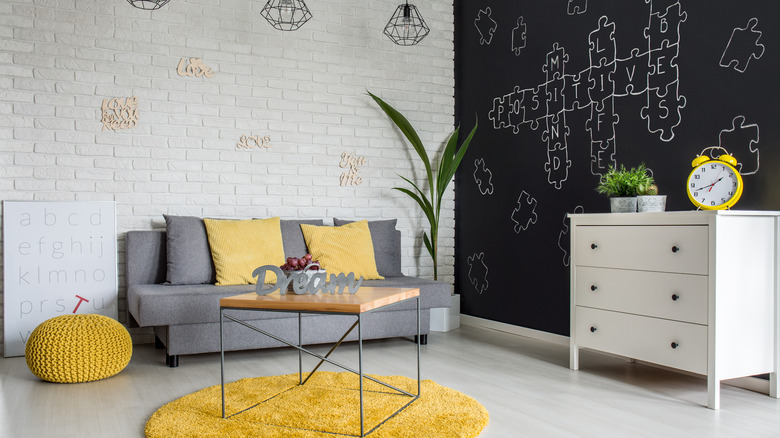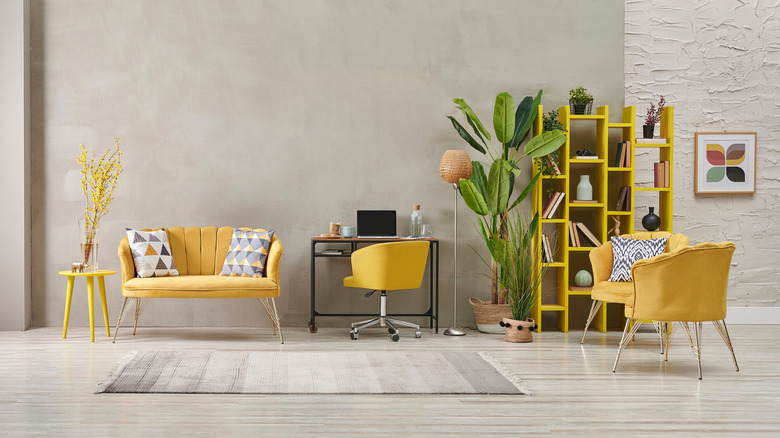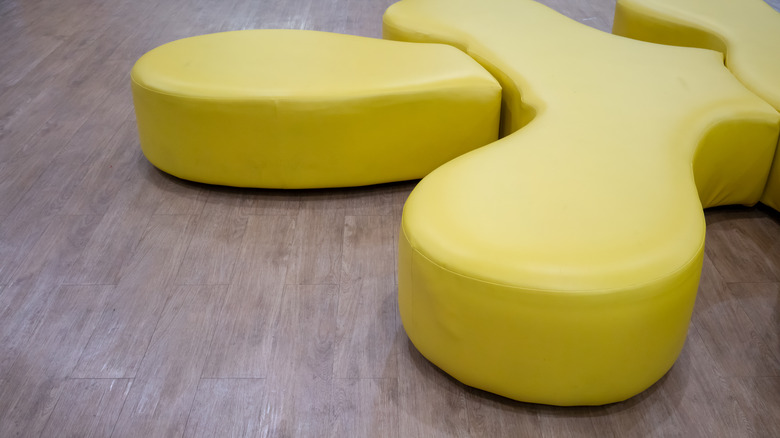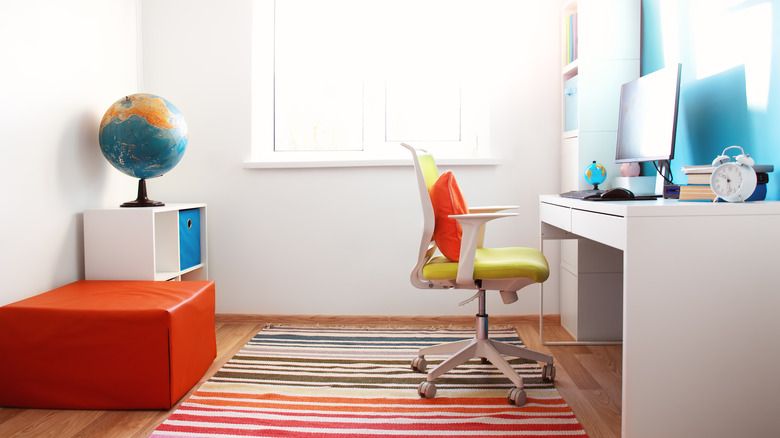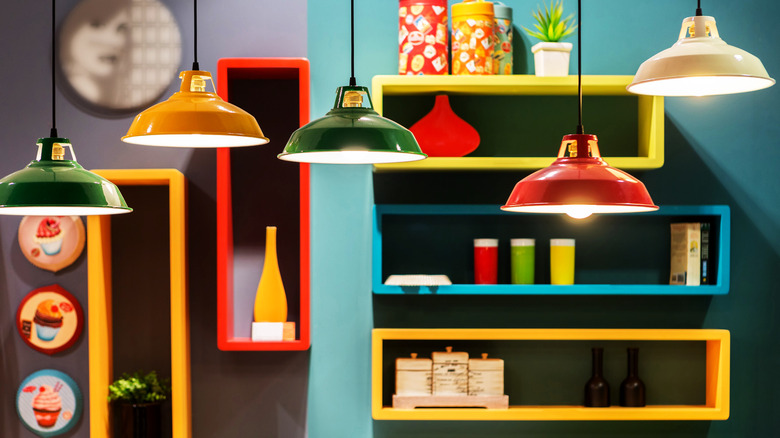4 Ways To Incorporate Kindercore Into Your Home Décor
First identified by The Strategist in late 2019, the kindercore style has been slowly creeping its way into the decorating world with its chunky furniture, bold colors, and whimsical geometric accents. According to Haute Living, the style takes its inspiration partially from the Bauhaus movement of the early 20th century, a German movement of artists and architects whose style embodied clean lines and a geometric focus with avant-garde touches.
Kindercore also takes its inspiration from a childlike sense of wonder embodied in larger, adult-sized portions. Rooms are often sparse but not exactly minimalist. Instead, they employ bold, saturated, and primary colors in a liberal way — kindercore rooms abound with playful accents with a sense of whimsy and joy. The style's very name employs "kinder," the German word for children, indicating a strong impulse toward the playful happiness of youth.
Hallmarks of kindercore style include a bold use of color, as well as whimsical accents and accessories, geometric shapes, chubby, comfortable furniture, and flexible spaces. Whatever the level of desire you have to bring some of the playfulness and joy of kindercore into your home, there are a few key places to begin.
1. Go for bright and bold colors
Kindercore loves highly saturated and bright primary colors easily found in a box of crayons. While the walls of a kindercore space can vary from painted to stark white, colored elements play a starring role, whether it's a bright red couch, a yellow chubby overstuffed chair, or rainbow-painted cabinets and drawers. Since much of the philosophy behind this style is its joy, think happy colors and bold strokes. As a result, fluorescents and bright primary shades are popular.
However, a more subtle approach is also fantastic for those who don't want to make it all about kindercore. Starting with several colorful décor items like a throw pillow, a blanket, a carefully placed vintage clock, and so on will give the room enough pizzazz to conform with the style. According to Saatva, it's best to choose a color concept that you are comfortable with. While many kindercore rooms have a neutral base, these bold pops of bright color bring a happy contrast to otherwise subdued spaces. Kindercore rooms often feature brightly colored seating, but you can also choose colorful items for any part of the décor, including lamps, rugs, and cabinets.
2. Chubby seating
Property Report PH describes kindercore as "chubby décor" for its rounded, chunky furniture elements that often evoke toys like blocks, puzzles, and Lego bricks. Kindercore furnishings often embody softness, with rounded lines and low-to-the-floor shapes. Modular sofas and other pieces are popular, offering flexibility that's usually desired in kindercore spaces. Unfortunately, many kindercore pieces echo the lines of sleek Modernist or traditional Bauhaus pieces but overstuff them in the name of comfort and style.
Colorful ottomans and poufs are popular in kindercore, as are low-slung boxy or rounded chairs. The vintage Eames-style plastic chair with its rounded seat and back is a favorite, often evoking the bygone days of grade school classrooms. According to Saatva, the most popular room for kindercore style is the bedroom, which benefits from a soft, cozy style emphasizing comfort, playfulness, and informality. However, kindercore also works well for living rooms, offices, and children's rooms, where the low and cushy style of furniture is a favorite for kids of all ages.
3. Storage
Despite its eclectic range of inspirations (Bauhaus, Modernism, children's play), kindercore is a curated look that tends toward both minimalism and maximalism at the same time. Interiors are often populated with quirky, original touches but typically do not involve the clutter of other eclectic styles. Thus, in spaces where storage is at a premium, kindercore-inspired shelving and cabinetry are a must.
Like the softer pieces, these harder furnishings are often brightly colored. Try a grid bookshelf with multi-colored drawers or painted interiors to hold books and media, or a brightly-hued storage ottoman. Painted cabinets and dressers with alternating colors are popular, as are storage cubes in a number of bright colors. Most tables, cabinets, and desks have simple straight or geometric lines that greatly contrast the seating pieces' more rounded voluptuousness. Natural wood grain furnishings in lighter shades are popular, as are plastic and fiberglass pieces in bold colors. According to Urban Quarter, look for non-traditional shapes, including half-moons, rounded edges, and cylinders for accent tables and smaller pieces.
4. Accents and art
Accent pieces are where kindercore really shines, offering a chance to create one-of-a-kind unique spaces. According to Grayson Luxury, kindercore is partly a reaction against the stark minimalism of many modern styles, offering more playful, comfortable, and laid-back interiors. In addition, accessories offer the chance to bring truly distinct show-stoppers and unique pieces into our interior in a very intentional way. This may include elements inspired by school room décor, like puzzles and games, large globes, giant Legos, and playful sculptural objects.
Kindercore thrives on geometric lines, so consider using hexagons, triangles, and spheres as decorative elements when choosing accessories and artwork for the walls. In addition, kindercore rooms often amplify the childlike quality of the design scheme by bringing in oversized pieces like clocks, spherical vases, and other whimsical touches. Rugs can also add playfulness and comfort to the space, particularly thick pile carpets and non-traditional shapes.
